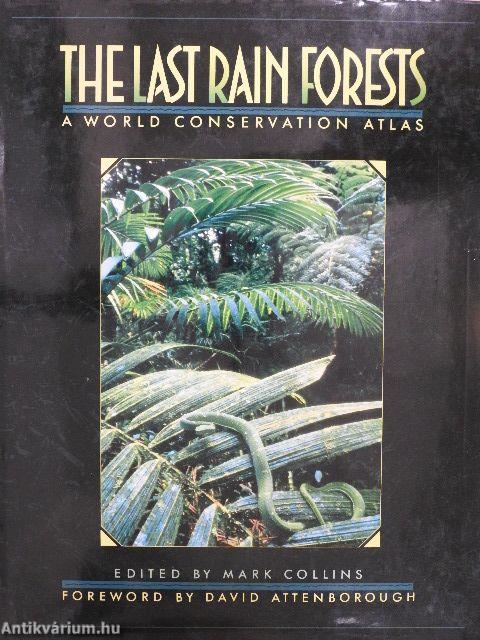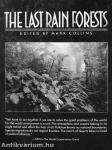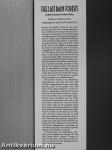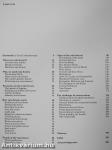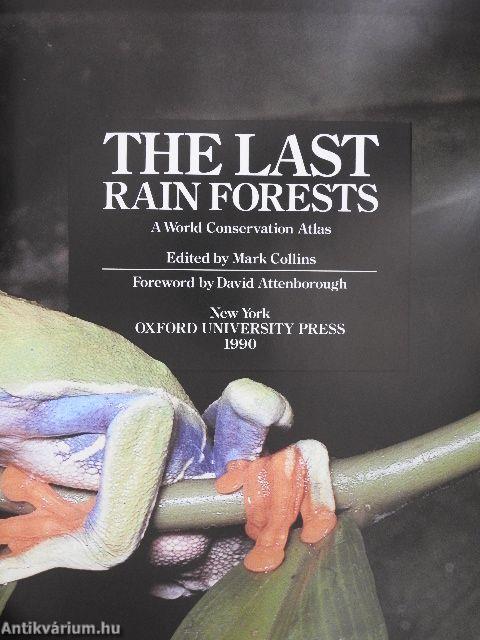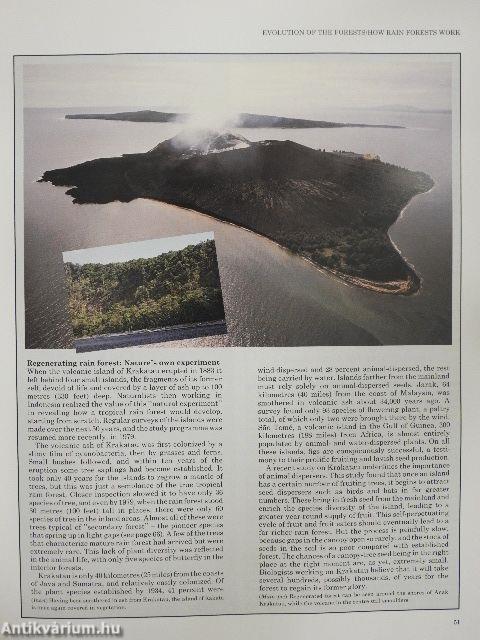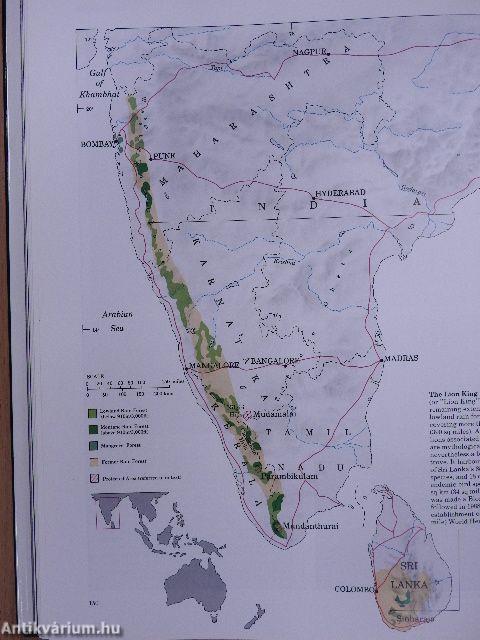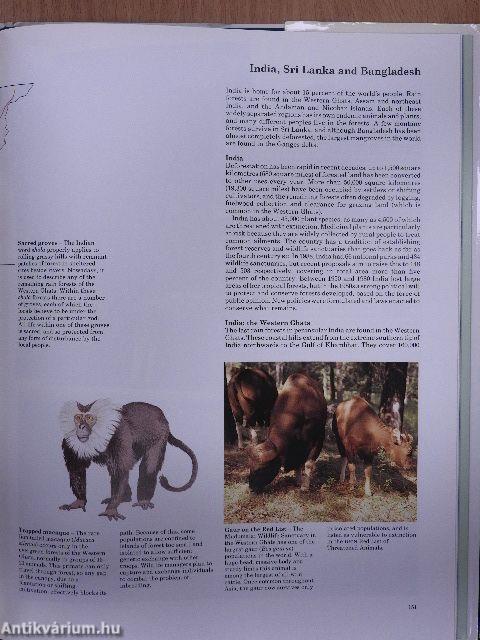1.067.017
kiadvánnyal nyújtjuk Magyarország legnagyobb antikvár könyv-kínálatát

VISSZA
A TETEJÉRE
JAVASLATOKÉszre-
vételek
The Last Rain Forests
A World Conservation Atlas
| Kiadó: | Oxford University Press |
|---|---|
| Kiadás helye: | New York |
| Kiadás éve: | |
| Kötés típusa: | Varrott keménykötés |
| Oldalszám: | 200 oldal |
| Sorozatcím: | |
| Kötetszám: | |
| Nyelv: | Angol |
| Méret: | 30 cm x 24 cm |
| ISBN: | 0-19-520836-6 |
| Megjegyzés: | További kapcsolódó személyek a könyvben. Színes fotókkal, illusztrációkkal, térképekkel. |
naponta értesítjük a beérkező friss
kiadványokról
naponta értesítjük a beérkező friss
kiadványokról
Előszó
TovábbFülszöveg
TilE MN M
EDITED BY MARK COLLINS
"We have to act together if we are to solve the great problems of the world. For the world environment is a unit. The atmosphere and oceans belong to no single nation and affect the lives of all. Pollution knows no national boundaries. Species migrations do not respect frontiers. The march of deserts takes no heed of political alliances."
—lUCN—The World Conservation Union
A World Conservation Atlas
EDITED BY MARK COLLINS FOREWORD BY DAVID AHENBOROUGH
As seen from Skylab a mere ten years ago, the Amazon Basin was a dense expanse of trees stretching from horizon to horizon. Broken only by winding rivers, it was a lush image of endless growth. More recent photographs, however, depict quite a different landscape: a blazing forest enshrouded in a vast cloud of smoke that thins only at the foot of the Andes. Once it was difficult to comprehend the extent of rain forests; now it is hard to comprehend the extent of their destruction. In 1989... Tovább
Fülszöveg
TilE MN M
EDITED BY MARK COLLINS
"We have to act together if we are to solve the great problems of the world. For the world environment is a unit. The atmosphere and oceans belong to no single nation and affect the lives of all. Pollution knows no national boundaries. Species migrations do not respect frontiers. The march of deserts takes no heed of political alliances."
—lUCN—The World Conservation Union
A World Conservation Atlas
EDITED BY MARK COLLINS FOREWORD BY DAVID AHENBOROUGH
As seen from Skylab a mere ten years ago, the Amazon Basin was a dense expanse of trees stretching from horizon to horizon. Broken only by winding rivers, it was a lush image of endless growth. More recent photographs, however, depict quite a different landscape: a blazing forest enshrouded in a vast cloud of smoke that thins only at the foot of the Andes. Once it was difficult to comprehend the extent of rain forests; now it is hard to comprehend the extent of their destruction. In 1989 alone, more than 55,000 square miles of rain forests were lost around the world: burned for cattle ranching and small-scale farming, flooded by dam projects, plundered for precious ores, timber, and rare species of animals and plants, scarred by roads built by the ravaging invaders. If the present rate of deforestation continues, many rain forests in tropical America, Africa, and Asia will be gone by the end of the next century. In fact, less than .02 percent ore currently being managed on a sustainable basis.
The Last Rain Forests is an authoritative, comprehensive, and—with more than 200 full color photographs and maps—stunningly beautiful guide to the people, flora, and fauna of the richest habitats on earth. Prepared in collaboration with the International LJnion for Conservation of Nature, a consortium of some 500 major conservation organizations across the globe, and the World Conservation Monitoring Centre, this is the first popular reference to map the world's rain forests, spell out the problems facing these regions, and propose realistic strategies for ensuring their survival. It discusses in detail what the world's rain forests are, how they work, who lives in them, and why we need them, and explores the threats they face today. The volume then presents a unique, thoroughly up-to-date atlas of more than fifty rain forests, from the Caribbean to Central Africa, from Brazil to Bangladesh. It concludes with concrete proposals for saving these imperiled regions and, ultimately, our planet.
A pictorial feast, an authoritative reference, and a blueprint for change, The Last Rain Forests allows readers to shape informed opinions—and take positive action—on one of the most pressing environmental issues of our day. Vissza
Témakörök
- Idegennyelv > Idegennyelvű könyvek > Angol > Természettudományok > Biológia
- Idegennyelv > Idegennyelvű könyvek > Angol > Természettudományok > Földrajz
- Természettudomány > Földrajz > Általános természeti földrajz > Élővilág
- Természettudomány > Földrajz > Kontinensek földrajza > Téma szerint > Növényzet, állatvilág
- Természettudomány > Földrajz > Idegen nyelv > Angol
- Természettudomány > Biológia > Ökológia, környezetvédelem > Környezetvédelem > Általában
- Természettudomány > Biológia > Ökológia, környezetvédelem > Kézikönyv
- Természettudomány > Biológia > Ökológia, környezetvédelem > Ökológia > Általában
- Természettudomány > Biológia > Ökológia, környezetvédelem > Idegennyelvű
Megvásárolható példányok
Nincs megvásárolható példány
A könyv összes megrendelhető példánya elfogyott. Ha kívánja, előjegyezheti a könyvet, és amint a könyv egy újabb példánya elérhető lesz, értesítjük.



